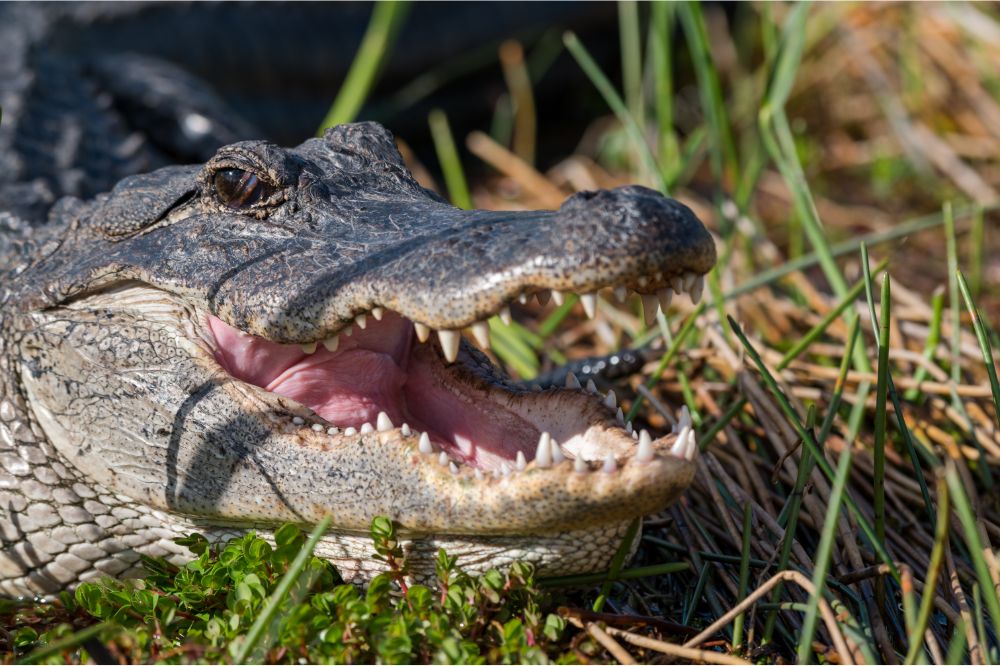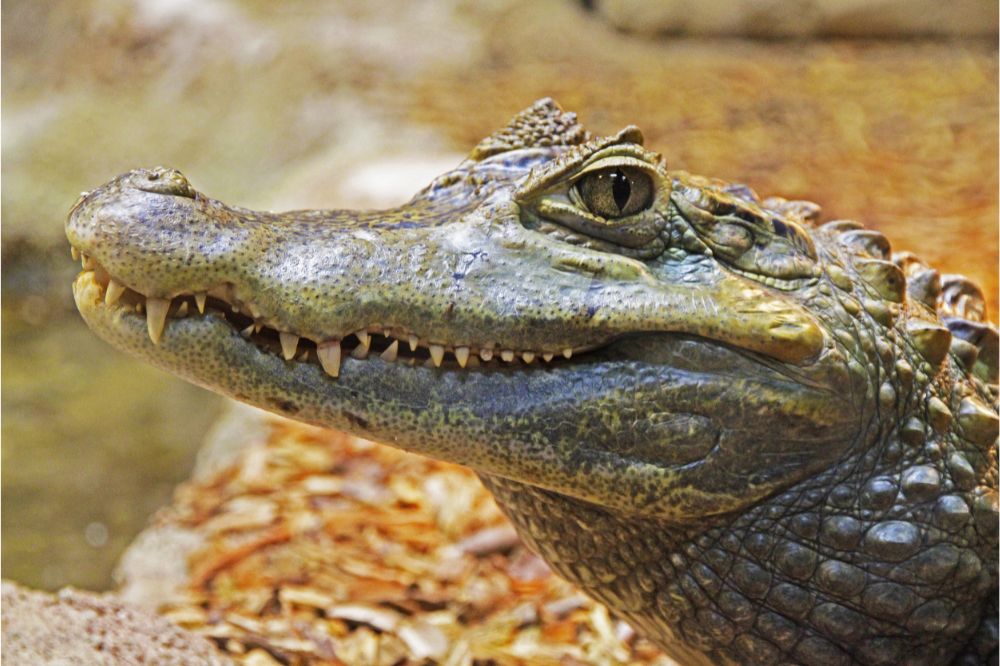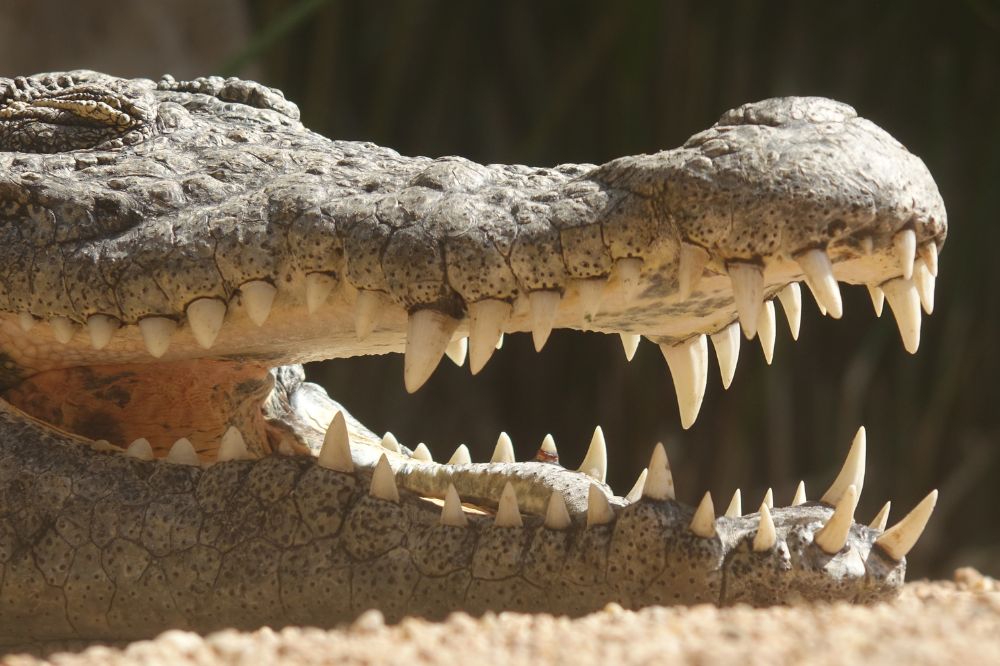Alligators have been around since the time of the dinosaurs and have changed little since then – they are perfectly adapted for their watery habitats and can easily make a meal of just about anything that comes within the range of their snapping jaws.
One important feature of an alligator’s anatomy that has allowed them to be so successful is their teeth – and in this post, we go into the details of how alligators hunt and feed as we answer the question, how many teeth does an alligator have?
If you’re curious about just how big alligators can grow, you can check out this video before reading on.
How Many Teeth Does an Alligator Have? The short answer
The subject of alligators’ teeth is a fascinating one, and there’s quite a bit more to this topic than many people might imagine.
However, before we get into the details, let’s start with the short answer.
How many teeth do alligators have? An adult alligator usually has around 76 to 80 teeth at any one time.
Furthermore, alligators are what’s known as polyphyodont, which means their teeth constantly fall out and grow back.
As a result, an alligator will usually get through around 2-3000 teeth during its lifetime.
But as we mentioned, there’s so much more to alligators’ teeth than just this, so now let’s jump in and look at the topic in a bit more depth.
Perfectly adapted to the way they feed

When you picture an alligator, you might imagine a fearsome reptile with a mouth full of long, sharp teeth, but if you get close enough to have a good look, you’ll probably notice two things.
The first is that not all the teeth are the same length and the second is that they’re not particularly sharp.
Both of these facts are related to the way that alligators use their teeth, and it’s clear that they are perfectly adapted to the way an alligator feeds.
Unlike animals with sharp teeth like sharks, alligators don’t bite through their prey – and unlike us, they don’t chew their food either, which is why they don’t have any molars.
Instead, alligators have relatively blunt conical teeth that are pointed backwards, which helps them hold onto any animal they manage to catch.
Coupled with this, alligators have an incredibly powerful bite – it is thought that an alligator can generate a pressure of up to 300 pounds per square inch, giving them one of the most powerful bites in the animal kingdom.
As a result, any animal unfortunate enough to find itself in the jaws of an alligator is extremely unlikely to be able to get free unless the alligator decides to let go.
Different length teeth for different purposes
Alligators have a varied diet that consists of just about any poor animal they can get hold of, and this includes small and medium-sized mammals, birds, reptiles, frogs, snails and other invertebrates.
Their diet also changes as they grow, with larger alligators being able to take larger types of prey.
The longer teeth are ideal for gripping larger prey that might try to wriggle free from the alligator’s jaw – but the shorter teeth are also used for crushing.
The shorter teeth can withstand the force delivered by an alligator’s jaw, giving alligators the ability to crush just about anything, even a turtle’s protective shell.
For this reason, alligators tend to have shorter teeth than crocodiles since they use them more for crushing while crocodiles use them more for grabbing and holding on.
That said, crocodiles also have impressive bite power, and the saltwater crocodile has the strongest bite of any animal in the world, beating even the power of the alligator in this department.
Interestingly, alligators’ teeth are hollow, and while this may weaken the teeth slightly, putting them more at risk of breaking, it also means a replacement tooth can grow beneath each tooth, minimizing the amount of time an alligator spends with a gap when a tooth breaks.
How do alligators catch and eat their prey?

Alligators are ambush predators that catch their prey by surprise – they can swim below the surface of the water right up to where a potential victim is taking a drink and then lurch out of the water to catch their prey in their mouth.
If the prey is small enough, the alligator will then just swallow it whole.
However, if the prey is larger, the alligator may perform what’s known as a “death roll” where it rolls over with the prey in its mouth until a smaller chunk of meat is ripped off for the alligator to eat.
We’ve already mentioned that alligators don’t chew their food because they don’t have the teeth for this. However, they often carry stones in their stomach, which help break down food in much the same way as some birds use gizzard stones.
Despite their awesome bite force, a side effect of the fact that alligators haven’t evolved to chew is that the muscles used to open alligators’ mouths are surprisingly weak.
As a result, although a human would find it almost impossible to prize open the closed jaws of an alligator, most people would be able to hold an alligator’s mouth closed with nothing more than their bare hands.
Alligators can also be easily restrained with nothing more than a few wraps of duct tape around the mouth – although if you find yourself confronted by an alligator, it’s best to call in the pros rather than trying to do this by yourself!
FAQs
What’s the difference between alligators and crocodiles?
Although alligators and crocodiles may look superficially similar and have similar lifestyles – and both belong to the order Crocodilia – their lineages split in the late Cretaceous period around 87 million years ago.
Nowadays, alligators are found only in the United States and China while crocodiles are spread over a far wider range. There are also more species of crocodiles than there are of alligators.
In general, alligators have a broader U-shaped head while crocodiles have a more pointed V-shaped snout, and another way to tell them apart is by the arrangement of their teeth.
How can you use the teeth to tell an alligator from a crocodile?
Although they diverged many millions of years ago, it can still be difficult for people to tell alligators and crocodiles apart.
However, perhaps the easiest and most reliable way to do it is to look at their teeth.
With its mouth shut, the only teeth that should be visible in an alligator’s mouth are the top ones. This is because alligators have grooves in their upper mouths that the teeth from the lower jaw fit into.
With crocodiles, on the other hand, some of the teeth from the lower jaw remain outside of the crocodile’s mouth when the mouth is closed.
How many species of alligator are there?
Today, there are only two species of true alligator, the American alligator (Alligator mississippiensis) and the Chinese alligator (Alligator sinensis).
The American alligator has its natural range from southern Texas to North Carolina while the Chinese alligator is now found only in China’s Anhui province as well as possibly in Jiangsu and Zhejiang provinces.
The American alligator grows up to 15 feet in length and can weigh up to 1,000 lbs. The Chinese alligator is smaller, reaching a maximum length of about seven feet and weighing up to 100 lbs.
Closely related to alligators are the caimans, which are native to Mexico, Central America and South America. Several species exist, with the biggest, the black caiman, reaching 13 feet in length and weighing up to 2,200 lbs.
How often do alligators eat?
Alligators have a much slower metabolism than us, so for an adult alligator, it’s quite normal to go for a whole week or longer without a meal.
Do alligators attack humans?
Unlike some larger species of crocodile – like the saltwater crocodile or the Nile crocodile – alligators don’t usually see humans as prey and won’t attack adult humans for food.
However, an opportunistic alligator may attempt to take a child seen playing near the water if the chance arises.
It is more likely that an alligator will attack a human out of self-defense when cornered – and a mother will also attack a human to defend her nest.
They’re not afraid to chase off humans that enter their territory either, as this video shows.
Are alligator bites dangerous?
Although alligators don’t actively hunt adult humans, an alligator bite can be extremely dangerous – and painful at the very least.
As we’ve mentioned, they possess extreme power in their jaws, and they can easily crush the bones in a human arm or leg.
Furthermore, a large alligator is quite capable of dragging a human into the water, and the victim may then be drowned by the animal – or if the alligator performs a death roll, may potentially lose a limb.
Although relatively rare, fatal alligator attacks have been recorded. Most attacks and deaths occur in Florida, but they can also happen wherever alligators are present.
Perfectly adapted teeth and a powerful bite
The alligator’s teeth and its powerful bite are two adaptations that make it such a successful hunter – because once it clamps its jaws on its prey, it’s almost impossible for the stricken animal to escape.
Alligators don’t usually actively hunt humans, but they have dangerous bites and will fight to defend themselves. And several fatalities have been recorded over the years, so it’s best to exercise caution whenever you’re near water in alligator country.

